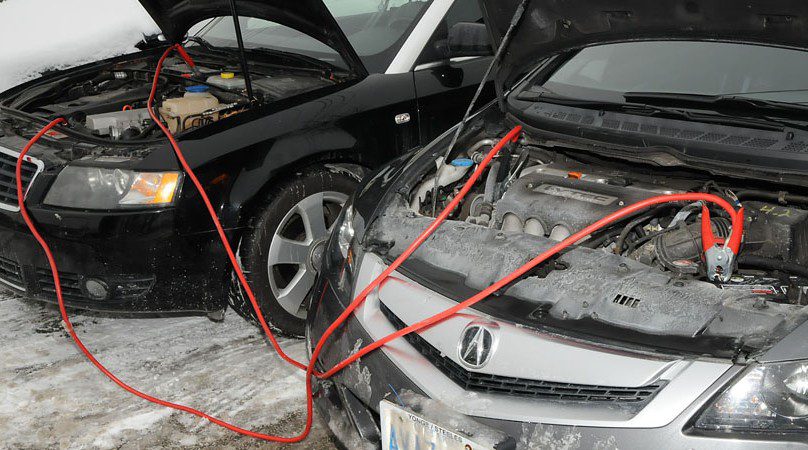
You wake up on a very cold morning, rushing to work and you crank your car but it will not just respond or better still you go out with your kids and while you were busy talk to someone you leave the kids in the car. By the time you are back you crank the engine but it will not just start, I know some of you might be familiar with this scenario. Today I will be sharing 3 basic ways to jump your car to start.
Pop starting, bump starting, crash starting, or popping the clutch

- This method of jump starting is only for manual transmission cars. (Don’t attempt this alone)
- Get two or three friends to push the car for you while you are in the driver’s seat.
- While the push put the car in the second gear while holding down the clutch.
- Put your ignition in On.
- Once the car gains some good momentum release the clutch while you press down the accelerator a quarter way down, hold it till the engine comes alive.

Using a jump cable.
This method can be use for both manual and automatic transmission, but you must have a source either a running engine or a fully charged battery. Also See https://www.google.com/search?q=How+to+Jump+Start+a+Car&source=lmns&bih=760&biw=1536&rlz=1C1CHBF_enNG880NG880&hl=en-GB&sa=X&ved=2ahUKEwjS6aHuz7L3AhVmqHIEHWwvCY4Q_AUoAHoECAEQAA#kpvalbx=_jV1oYpjGLcmZ_Qbc67so16
- Get you jump cable
- Connect the red cable (positive) to the positive of your car battery
- Connect the black cable (negative) to the negative of your car battery
- Repeat the above with the charged battery you want to jump start with.
- Ensure that the connections on both sides are firmly connected.
- Do not allow positive and negative clamps to come into contact with each other.
- Crank your engine and it will come alive.
- Disconnect and allow engine to run for 10mins to charge up your battery.

Using a portable jump starter
Portable jump starters (aka battery boosters, emergency boosters, battery jumpers, and jump boxes) can be used anywhere. They don’t need to be plugged into an outlet.
They also don’t re-charge your battery, but rather provide the necessary amperage to crank the engine and start the vehicle. Once the engine is on, the alternator will charge the battery and power the electrical system.
Jump starters rely on a battery as their power source. As a result, they must be periodically recharged. Always recharge your portable jump starter/battery booster pack after each use and at least once every 6 months. These jump starter batteries will lose their charge more quickly if left in the car during hot and cold weather.
- Look up your battery charger’s voltage in the owner’s manual. Make sure it matches the jump starter’s output voltage. This is normally a 12-volt supply.
- Identify the positive (look for the “P,” “POS,” or “+” symbol) and negative terminals (look for the “N,” “NEG,” or “-“symbol) on your car battery. Remove any excessive corrosion before attaching the cables.
- Identify the positive and negative clamps/clips on the portable jump starter. The positive charger clamp is red and the negative charger clamp is black.
- Make sure the jump starter is “off” before attempting to connect the jumper clamps to the vehicle’s battery.
- Do not allow positive and negative clamps to come into contact with each other.
- With both the car and jump starter turned off, connect the jumper cables to the appropriate terminals.
- First connect the red clamp to the positive terminal on the battery.
- Then, connect the black clamp to a clean, unpainted, and non-moving metal part. Choose an area on the car’s frame or engine block, far away from the battery, carburetor and fuel lines. Never use fuel lines, engine rocker covers, or the intake manifold as grounding points!
- Make sure the clamps are solidly connected so they don’t get shaken loose.
- Once the jumper cables are firmly in place, you can turn on the portable jump starter.
- Now, you can try to turn the car on.
- Do not crank the engine for more than 5 seconds. If the car won’t turn on after the first attempt, wait around 2-3 minutes to try again. You may need a new battery if the car won’t start after 4 or 5 attempts.
- After the engine starts, turn the jump starter off.
- Then, remove the negative (black) clamp followed by the positive (red) clamp. Now, safely store the portable jump starter.
- After the clamps have been removed, allow the vehicle to idle for several minutes before taking off. https://quickautobrain.com/toyota-solid-state-battery-development/